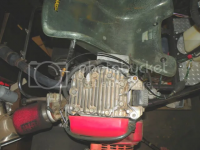I recommend using transparent fuel lines so you'll know if your carbs receiving fuel or not. And I recommend using 1/4" automotive fuel line for your pulse signal line. The clear line flexes too much reducing the pulse signal reaching the pump.
Cracking the bowl drain works too, but great advice on the pulse line!
Returns lines , extra fittings, and half open valves aint my style tho.
I just grab the round mikuni plastic pumps off lawnmowers, they are designed to work off the crankcase
of our 4 cycle go kart motors, and put out the right pressure , so you just hook it up like it's intended,
outlet right to the carb, and it works like factory! Think I got 5 in service right now, no issues. On factory carbs
and mikuni round slides.
The honda gc160 -190's use the same mikuni pump from the factory, driven off the crankcase, with no return!




